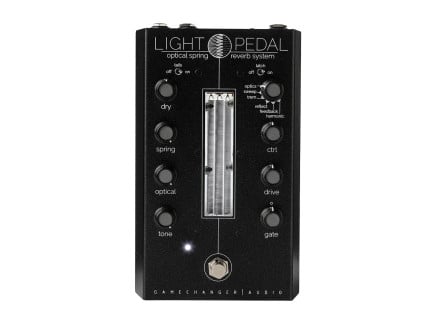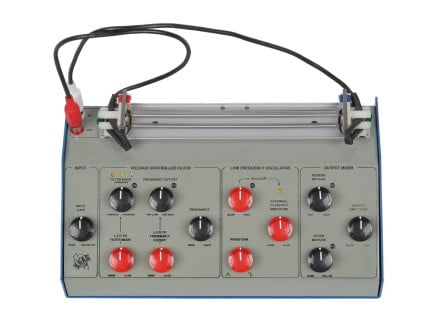Effect processing is a standard part of a huge number of music-making workflows—from guitar performance to synthesizer sound design and studio production as a whole. In fact, many synthesizers and audio production softwares come with a large host of effect processing tools built in...making it possible to envelop any sound in layers of processing and timbral depth.
Of course, one of the best-loved and most ubiquitous ways of processing sound is reverberation, or reverb. But what is reverb? Simply put, reverb is an audio effect that mimics the behavior of acoustic spaces—making it possible to artificially create a sense of space. This can range from the sounds of realistic room ambiences to unlikely or downright impossibly large reverberant spaces, with infinite audio trails dripping off into infinity. Simple instrumental sounds can transform into something vast, and the sound of space can become a playable instrument all its own.
In the video above, our pal Wes delivers possibly the fastest reasonably thorough (and remarkably entertaining) explanation of reverb that I've ever heard. In this article, we're going to go a little bit deeper, taking a quick look at a few historical ways of producing reverb up to the present day. If you've ever been curious about how reverb works and what you can do with it, read on!
What Is Reverb, Really? And Why Do We Like It? (or: Hearing is Weird)
Before diving into the "how" of things, let's take a minute to discuss the "why." That is to say—why is reverb such a popular form of effect processing?
In our daily lives, reverberation is all around us: in fact, it's a critical part of how we perceive our immediate surroundings. People who have the ability to see often think of sight as being the most critical sense for decoding our surroundings—however, our sense of hearing alone is powerfully attuned to our environment. Astoundingly minute differences in the qualities of seemingly simultaneous sounds arriving at each ear can instantly tell us so much about the size, shape, and density of the spaces we inhabit. Even with a single ear alone, it's possible to understand quite a lot about the space you're in.
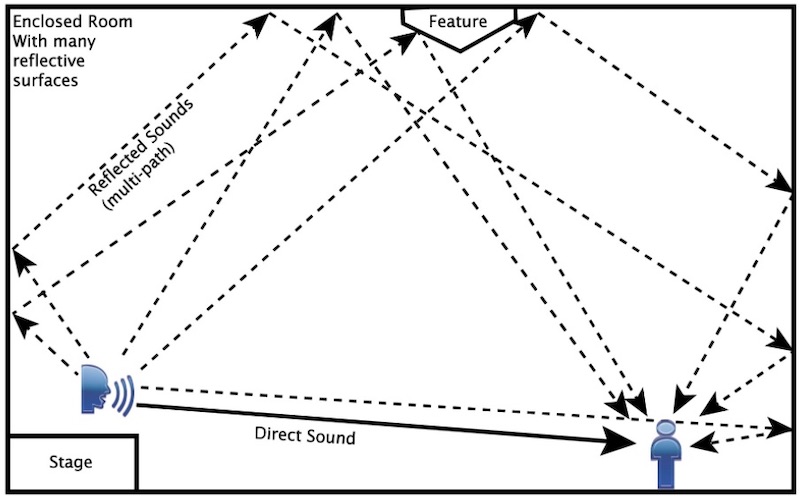 An elegant reverb diagram via newmusicworld.org
An elegant reverb diagram via newmusicworld.org
Why? Because real-world spaces contain reflective surfaces—hard surfaces that sound bounces off of. Because sound travels in all directions, you seldom hear a direct sound source purely in isolation: instead, you hear the sound source followed quickly (usually seemingly instantaneously) by that same sound's reflections off the room's walls, floor, and ceiling. Our brains instantly decode minute differences in the arrival time of those reflections and their general sound quality in order to help us understand the room we're in: is it big, or small? Made of stone, or wood? Are we close to the sound source, or far away? This sense of space is an intrinsic part of how we hear every sound in the real world, and therefore is a critical piece of how we perceptually relate ourselves to our surroundings. That's what reverb is in real life: sound bouncing around a space, and the arrival of those reflections at your ears translating into an acoustic understanding of what the space itself is like.
In the days before recorded music (and before the advent of electric/electronic musical instruments), every sound that everyone ever heard had some form of natural reverberation. But as recorded music and electric/electronic musical instruments have advanced, though, it's no longer an absolute given that sound occurs in a real space: it's very possible, for instance, for the sound of an electric guitar to be recorded directly onto a computer, played back in headphones, and never subjected to the process of reverberation. This can be used for strong effect in recorded music—but it often sounds unnatural or even uncomfortable for sound to be completely devoid of the reflections that come from a real space. I'd posit that this is why artificial reverberation is so ubiquitous: it takes the unnatural aspects of electronic & recorded sound and helps to provide them a more lifelike, relatable character. Of course, part of the fun of reverb as an effect is that it can be manipulated to the point that it is no longer lifelike—but we'll address this more as we go on.
With this perspective in mind, let's take a look at some historical approaches for applying reverberation to electronic and recorded sounds. We'll start from the early days of creative effect processing in recorded music, eventually arriving at the current day.
The Early Days: Echo Chambers
I'd be remiss not to mention that natural reverb has been a part of music-making for longer than recorded history can tell us—or at least, we can assume so with reasonable certainty. Even in the early days of Western music history, specific spaces were built to cultivate particular acoustic properties, and music was written to highlight the natural properties of these spaces: cathedrals were assembled such that sound could project across space easily, surrounding the listener with a peculiar, otherworldly aural halo. Concert halls were also specially built with acoustics in mind; so in a sense, reverb has been a property of musical interest for quite a long time. For the sake of today's discussion, though, we're going to start with the earliest examples of inducing reverb in the context of artistic studio recording.
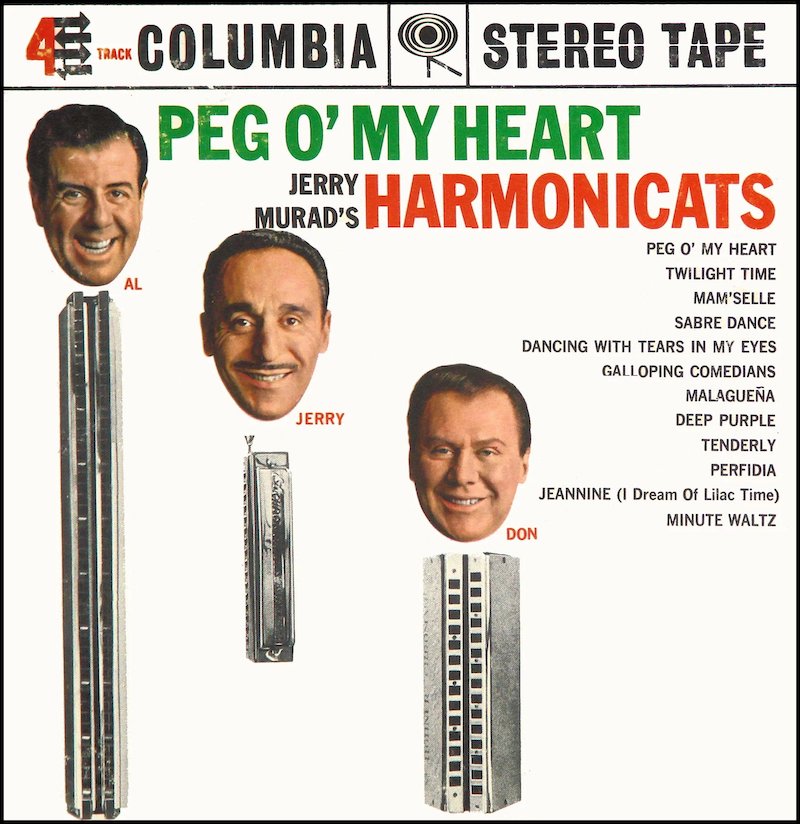 The pioneering album by Harmonicats: Peg O' My Heart
The pioneering album by Harmonicats: Peg O' My Heart
The first creative use of reverb in a studio recording of popular music is often credited to Bill Putnam: the eventual founder of Universal Audio, and the same man often credited as developing the modern recording console. His 1947 recording of The Harmonicats' Peg o' My Heart features a harmonica solo drenched in a seemingly otherworldly reverb—a sound that, at the time, hadn't been heard in popular music recordings. In fact, the reverb's source was anything but otherworldly...it was recorded in a bathroom in the Chicago Civic Opera Building, treating the bathroom as an echo chamber.
The idea of an echo chamber hinges on two of the key technologies that made recorded music possible altogether: loudspeakers and microphones. By placing at least one microphone and speaker into a particularly reverberant room (like a tile-floored bathroom, for instance), you can project a live sound or recorded sound into the space (via the speaker) and capture the reverberant sound of the space (via the microphone). This was the key to "artificial" reverb in early recorded music: and in fact, many studios still use their prized echo chambers from these early days. Capitol Studios and Abbey Road, for instance, provided the echo chambers heard on recordings by the Beach Boys and the Beatles, respectively—and their echo chambers are still functional to this day. In fact, these chambers have inspired audio plugins by Universal Audio and others that use convolution processes to emulate the sounds of these particular chambers...but more on that later.

While an echo chamber is an effective and kind of awesome way to add reverberation to recorded sound, it's fairly cumbersome and inflexible: after all, you can't change the size or shape of the chamber, so you can't vary the core sound of the reverb very significantly. This type of chamber was the predominant means of creating "artificial" reverberation in recording studios throughout most of the 1950s—but in the background, other options were brewing.
Metallic Resonances: Plate Reverb
In 1957, German Company EMT provided the first commercial alternative: the plate reverb. The original EMT140 plate reverb maintains the same core concepts as an echo chamber...but it goes a step beyond the obvious-yet-practical method of reamplifying sound in a reverberant room by reimagining some of the basic aspects of an echo chamber. Namely, it reconsiders the nature of the microphone and the speaker and does away with the room entirely.
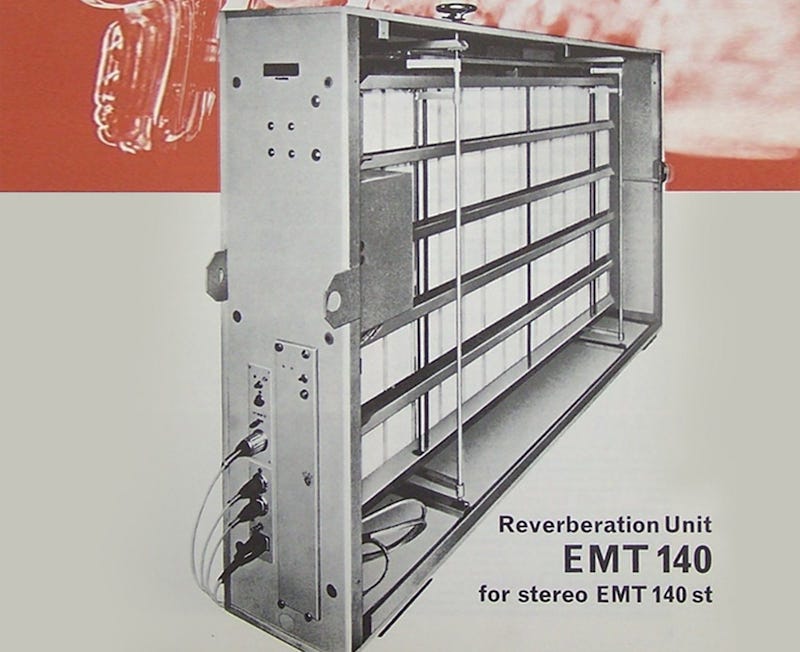
A plate reverb is a large semi-mechanical device that contains a large metal plate—the EMT140, for instance, contained a quite thin 2-meter by 3-meter metal sheet suspended from a metal frame. By coupling a speaker-like transducer to the metal plate itself, you can cause the metal plate to vibrate in sympathy with incoming signals. By coupling additional microphone-like transducers to the same plate, you can capture the sound of the vibrating plate itself...and in that way, the reverberant room is replaced altogether by this large, thin piece of metal. The EMT140 also contained a dampening plate which could be used to physically dampen the reverb plate itself, allowing for continuous variation of the reverb's decay time.
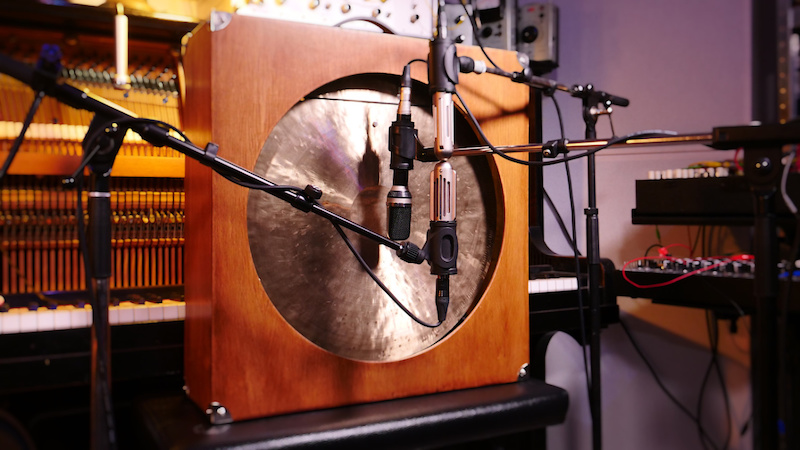 The Eowave Metallik in Hainbach's studio, a modern device inspired by the Métallique diffuser
The Eowave Metallik in Hainbach's studio, a modern device inspired by the Métallique diffuser
The EMT wasn't the only such device out there—for instance, as early as 1932, the ondes Martenot (a peculiar early electronic instrument tangentially-related to the theremin and the synthesizer) featured the Métallique diffuseur, a speaker that replaced the speaker cone with a gong in order to induce metallic resonances (check out the Gong Amp plugin by Audiothing and Hainbach for a sense of how this sounds). However, as far as we know, the EMT was the first such device designed for general-purpose use applying reverb to any sound...and it became a staple at recording studios across the world.
The sound of plate reverb is quite unique: it is broad, diffuse, and very open. It obviously doesn't sound exactly like a room—but it creates a spacious sense of ambience that sits quite easily in a mix, even with complex audio input: making it a great choice for drum ambience, complex mixes, and much more. While many original plate reverbs are still in use in studios across the world, you're unlikely to find any mass-produced modern units...but their sound is still quite alive in effect pedals, rack processors, and audio plugins. Universal Audio, for instance, makes a quite convincing emulation of the EMT140 for their UAD plugin line.
Of course, its biggest drawback of a plate reverb is that it is huge. But naturally, giant metal plates aren't the only reverberant metal objects out there: enter the spring reverb.
Surf's Up: Spring Reverb
Like many classic processes in studio production and electronic music, spring reverberation was borne out of research in telecommunications at Bell Labs.
In the 1930s, scientists at Bell Labs were seeking to simulate the delays associated with signal transmission over long telephone lines. They developed a device that used two transducers and a series of springs. The concept is similar to a plate reverb: one transducer acted somewhat like a speaker; it was connected to the springs, which would vibrate in sympathy with the movement of the transducer. These springs were attached on the other side to a microphone-like transducer, which translated the vibration of the springs back into electrical signals which could be recorded. By exposing some of the springs to a variable amount of oil, the springs could be dampened to varying degrees.
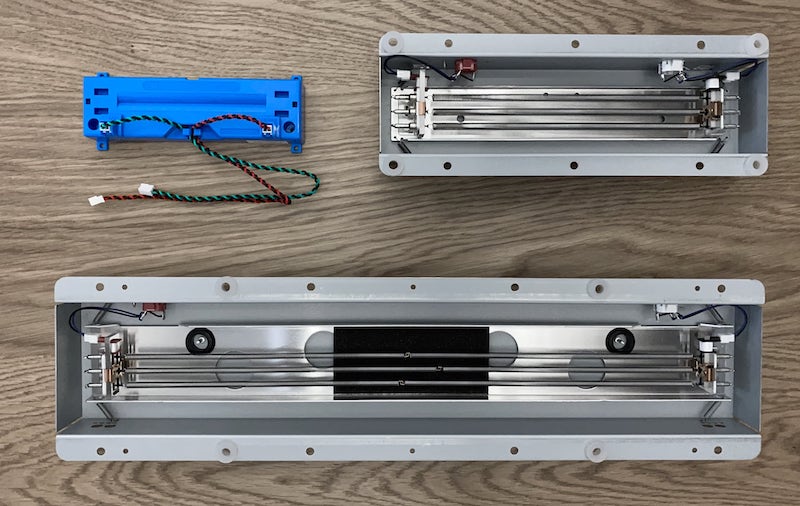
The net effect of sending audio through these springs and turning it back into an electrical signal was not unlike the sound of a reverberant space: as the springs vibrate, they impart a sonic character very similar to the reflections in a real acoustic space. It's surprisingly effective and uncanny. (See picture above for a selection of modern-day spring tanks...image courtesy of Intellijel.)
In the late 1930s, Laurens Hammond (founder of Hammond Organ Company), sought a technology that would allow his electromechanical organs to carry the sonic majesty and grandeur of a theater or concert hall pipe organ. Artificial reverberation was necessary: because his instruments were most often placed in homes, he couldn't count on their acoustic environment providing an optimal listening experience. Eventually discovering the Bell Labs invention and modifying it to their liking, Hammond Organ Company started adding spring reverbs as a default feature in their instruments, giving them a bouncy-yet-charming sonic signature that caught the ears of many.
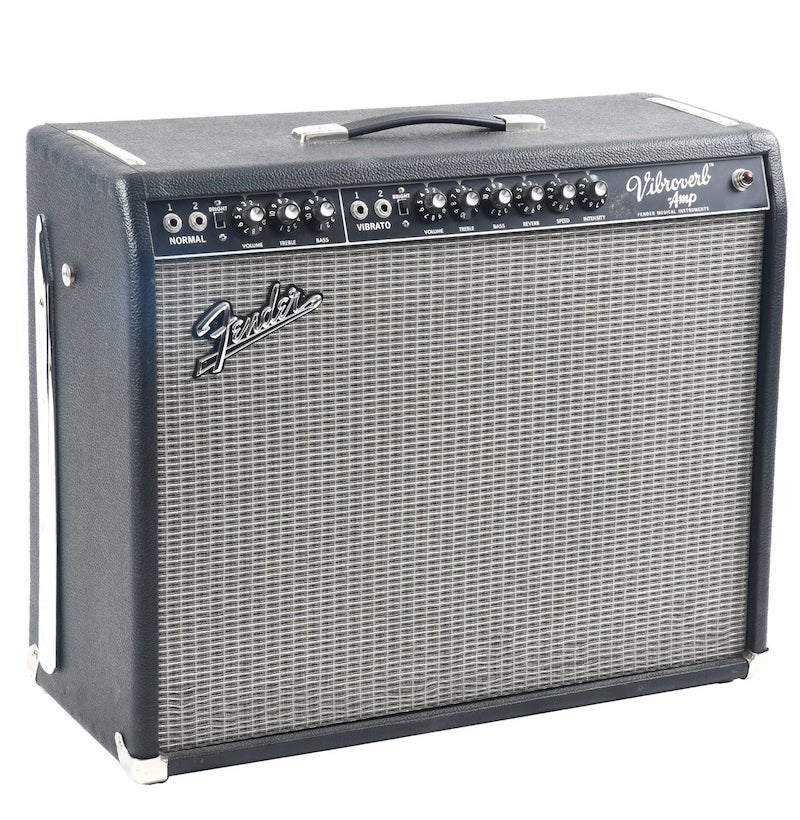 c. 2008 reissue of Fender's Vibroverb amplifier
c. 2008 reissue of Fender's Vibroverb amplifier
Perhaps most notably, Leo Fender was stricken by the sound of the Hammond reverb—and he sought to offer it to a wider audience. He marketed the Fender 6G15 Reverb Unit starting in 1961. The Reverb Unit was a standalone effect processor intended to add the reverb sound to your electric guitar and amplifier. Not long after, Fender introduced the Vibroverb: a 1963 guitar amplifier which incorporated the spring reverb directly into its design. This became a common feature in Fender combo amplifiers—and by proxy, it became a defining part of the sound of 1960s rock 'n roll, most notably in the beach-borne subgenre of Surf rock.
Because of their compact size and relative ease of implementation, spring reverbs also became a standard part of some of the earliest modular synthesizers, including instruments from EMS, Buchla, ARP, and many others. This effect has since been translated into a variety of formats, from rackmount studio processors to guitar effect pedals—and despite its relatively crude nature and its highly specific sound, spring reverberation is still a much-loved and highly relevant technique to this day.
The New Frontier: Digital Reverb
By the 1970s, it was clear to recording engineers that echo chambers, spring reverbs, and plate reverbs were only scratching the surface of what was possible. Simultaneously, companies like Eventide and Lexicon were making it clear that there was a strong future for digital technology in the world of audio processing. As such, it was only a matter of time before someone tackled the task of implementing a digital reverb.
Perhaps unsurprisingly, this was a feat first accomplished by EMT themselves (maybe they were tired of hauling giant plates around the world!). Their first digital reverb device was 1972's 144, but they quickly followed it with the more highly-refined EMT 250 in 1976, completed in conjunction with Dynatron. Peculiar by modern standards, the EMT 250 was a roughly radiator-sized device with large levers and backlit buttons, capable of a wide variety of reverb, echo, delay, and chorus effects.
Not long after, Lexicon—who previously had produced primarily digital delay processors—entered the reverb market as well, producing the now-legendary Model 224...often credited as being the first commercially accessible and "affordable" reverb...though it still cost ~$7500 at the time of its introduction. They weren't the only game in town at the time, however—for instance, that same year, Ursa Major released the SST282 Space Station, a rackmount reverb processor famed for its peculiar combination of reverb and delay-like behaviors.
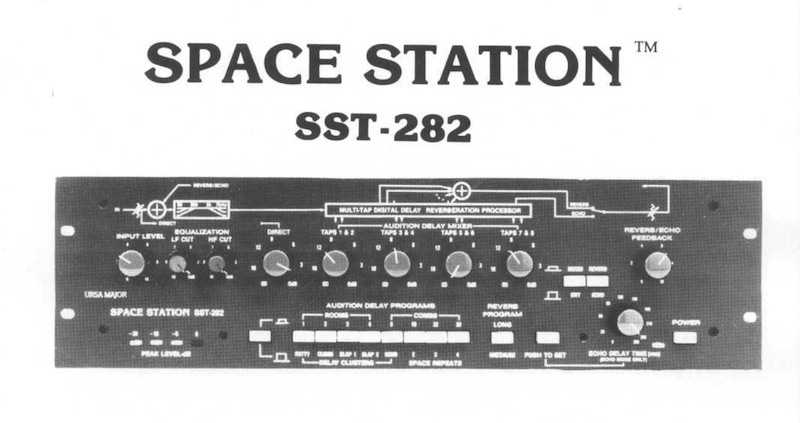
To this day most reverbs follow in the footsteps of these early digital devices, using similar internal processes to simulate the behavior of real spaces. But that brings up the question—how do digital reverbs work, anyway? The answer lies in our earlier definition of how reverb works in the real world: it's a collection of very rapid echoes, the result of sound bouncing off the surfaces in a room and arriving at our ears at ever-so-slightly different times.
Most digital delays rely on the use of multiple delay lines all tuned to mathematically unrelated, quite short delay times. Often, these delays are summed together (and/or inversely summed)—sometimes as a whole, sometimes in subgroups—and subjected to feedback at some point in the signal path. You can think of it like a lot of very short echoes that all feed into one another, creating a diffuse cloud of sound rather than a sensation of distinct, individual repeats. In some devices (including the Ursa Major Space Station), the delay times are subject to gradual modulation over time, forging an odd and unlikely sense of shifting atmospheres.
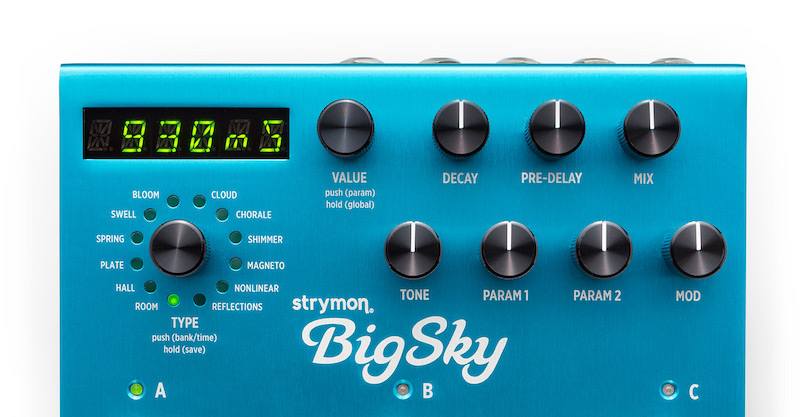 Algorithm selection and pre-set controls on the Strymong Bigsky
Algorithm selection and pre-set controls on the Strymong Bigsky
Because a good digital reverb has so many inner variables—from the timing of delay lines, to the way they are summed together, to where feedback happens and how much feedback is permitted—most digital delay processors resort to a preset-based method generally referred to as algorithmic reverb. In algorithmic reverbs, the user is usually presented with a series of reverb "types" to choose from. These types might include chamber reverbs, hall reverbs, room reverbs, etc., each meant to emulate the sound and behavior of their corresponding real-life spaces. In actuality, these are comprised of the same sorts of internal components as one another (delays, summing, feedback, filtering, etc.). The selected algorithm simply determines what specific arrangement of these processes is at play, and how the device's manual controls (for decay time/size, pre-delay, etc.) are mapped to the selected algorithm.
Of course, the significant continual improvements to digital signal processing mean that designers have gotten more and more creative with how reverb is implemented over the years. These days, pedal-format reverbs like Strymon's Nightsky or Meris's Mercury 7 incorporate internal pitch shifting processes to create evolving, shimmering spaces. Similarly, the revolutionary Make Noise/Sounhack Erbe-Verb Eurorack synth module (developed by Tom Erbe) turns the idea of algorithmic reverb on its head, providing continuous control of various internal parameters where most designers would provide only preset configurations...allowing you to create everything from realistic halls to impossible spaces where walls randomly appear and disappear as the room changes continuously in size. And of course, trailblazing company Eventide has constantly produced digital effects with an insane degree of customizability, providing the world with powerful multi-effect processors used to design some of the most iconic reverb algorithms ever heard (check out this article for more background). Digital reverb has opened up an unreal universe of sonic opportunity, one that we'll likely continue to explore indefinitely.
One other digital approach to reverberation is worth mention, though: convolution.
Recreating Real Spaces: Convolution Reverb
Convolution reverb takes a drastically different approach. Rather than using a network of delay lines to emulate the theoretical behavior of a real space, convolution uses impulse responses to recreate the sounds of real-life spaces with stunning accuracy. So that bears the question...what the heck is an impulse response?

An impulse response is a short recording, usually a recording of an impulse (like a balloon popping, or a starter pistol firing) or a sine wave sweep in a real-life space. We'll spare you some of the nerdy details, but in short, a convolution reverb can then use the impulse response audio file to determine the space's sonic behavior at every audible frequency, creating a sort of mapping that can mimic the sound of that real-life space with surprising realism. Convolution reverb plugins and hardware effect processors often include a wide range of impulse responses, allowing you to accurately recreate the sound of even quite famous cathedrals, echo chambers, and much more. (See above—Ableton's Convolution Reverb Pro, with the IR waveform displayed.)
Convolution reverb is very commonly used in audio post-production for film, making it easy to give foley sound and audio from a sound stage a much more realistic treatment. Of course, one of the most interesting aspects of convolution is that in reality, any sound can be used as an impulse response. What would it sound like if, for instance, you used the sound of a waterfall as your impulse response? Or a human voice? Or the gentle squeak of a rubber duck?
Convolution is a computationally complex process, and as such, there hasn't been much hardware dedicated to its exploration. These days, though, it's more common to see it used as a way of amp/cabinet modeling in effect pedals, or even as a general-purpose creative effect. For such devices, I'd strongly recommend checking out the Poly Effects Beebo and Hector, as well as the Tasty Chips ECR+.
So What's the Appeal? Bending Reality
Of course, there are countless other tricks and ideas about how reverb can be used. Gated reverb, famously discovered by accident by Phil Collins and co., is a technique in which the reverb tail is suddenly muted using a noise gate. There are powerful realtime "reverse" reverb effects, granular reverbs, pitch shifted reverbs, and much more. We couldn't hope to cover all of that here, and we hope that you've enjoyed the discussion of the ideas/techniques above.
Space will probably always be a source of fascination. As beings who can't escape the confines of three physical dimensions advancing in time, space will always be around us. But by manipulating our quite keen sense of hearing, we can create the sense of new spaces, even impossible spaces. What does it sound like as we advance toward a black hole? What if we were in a room the size of a golf ball? What if a sound could emerge out of its own reverb tail?
It's not just about making something sound like it's in a cathedral: reverb is one of the most immediate, striking, and downright effective tools that musicians have for warping reality.

